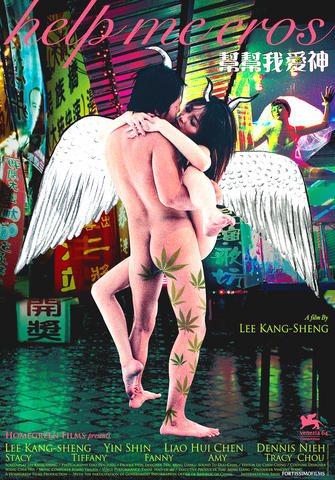To help promote their latest film, Help Me Eros (幫幫我愛神), Lee Kang-sheng (李康生) and Tsai Ming-liang (蔡明亮) have taken to the streets - they've embarked on a tour around Taiwan, giving lectures at universities that are free and open to the general public.
Tsai and Kang are both major figures in Taiwanese New Wave cinema. Tsai has directed eight-feature length films, all starring Kang, and he was executive producer for Kang's 2003 directorial debut, The Missing (不見). Help Me Eros, to be released on Jan. 11 in Taiwan, is Kang's follow-up to The Missing. Tsai is again contributing as executive producer.
Help Me Eros tells the tale of Ah Jie (Kang), a broke and destitute man who spends his days tending the marijuana plants he grows in a wardrobe. The stoner calls a hotline for help and gets to know Chyi (Liao Hui-chen, 廖慧珍), whom he falls in love with. Chyi repeatedly rejects Ah Jie, so he hits on Shin (Ivy Yi, 尹馨), a "betel nut beauty" who has a stall near his apartment.

PHOTO: LIBERTY TIMES
Though Kang and Tsai's works regularly show at the world's most prestigious film festivals and draw comparisons to French New Wave films of the 1950s and 1960s, they rarely meet with box office success.
To promote Eros, Kang and Tsai have sold tickets to pedestrians in the Ximending shopping zone (西門町) and at Shilin Night Market (士林夜市).
The lectures are in Chinese and feature a showing of the trailer to Help Me Eros, a lecture by both Kang and Tsai and a question-and-answer session.
Today from 3pm to 5pm they'll be at National Chengchi University (政治大學) and from 7pm to 9pm at National Taiwan University of Arts (台灣藝術大學). On Wednesday from 1pm to 3pm they'll be at National Hsinchu University of Education (新竹教育大學) and from 5pm to 7pm at Chung Yuan Christian University (中原大學).
Further information can be found at bloguide.ettoday.com/helpmeeros.

As I finally slid into the warm embrace of the hot, clifftop pool, it was a serene moment of reflection. The sound of the river reflected off the cave walls, the white of our camping lights reflected off the dark, shimmering surface of the water, and I reflected on how fortunate I was to be here. After all, the beautiful walk through narrow canyons that had brought us here had been inaccessible for five years — and will be again soon. The day had started at the Huisun Forest Area (惠蓀林場), at the end of Nantou County Route 80, north and east

Specialty sandwiches loaded with the contents of an entire charcuterie board, overflowing with sauces, creams and all manner of creative add-ons, is perhaps one of the biggest global food trends of this year. From London to New York, lines form down the block for mortadella, burrata, pistachio and more stuffed between slices of fresh sourdough, rye or focaccia. To try the trend in Taipei, Munchies Mafia is for sure the spot — could this be the best sandwich in town? Carlos from Spain and Sergio from Mexico opened this spot just seven months ago. The two met working in the

Exceptions to the rule are sometimes revealing. For a brief few years, there was an emerging ideological split between the Democratic Progressive Party (DPP) and Chinese Nationalist Party (KMT) that appeared to be pushing the DPP in a direction that would be considered more liberal, and the KMT more conservative. In the previous column, “The KMT-DPP’s bureaucrat-led developmental state” (Dec. 11, page 12), we examined how Taiwan’s democratic system developed, and how both the two main parties largely accepted a similar consensus on how Taiwan should be run domestically and did not split along the left-right lines more familiar in

This month the government ordered a one-year block of Xiaohongshu (小紅書) or Rednote, a Chinese social media platform with more than 3 million users in Taiwan. The government pointed to widespread fraud activity on the platform, along with cybersecurity failures. Officials said that they had reached out to the company and asked it to change. However, they received no response. The pro-China parties, the Chinese Nationalist Party (KMT) and Taiwan People’s Party (TPP), immediately swung into action, denouncing the ban as an attack on free speech. This “free speech” claim was then echoed by the People’s Republic of China (PRC),